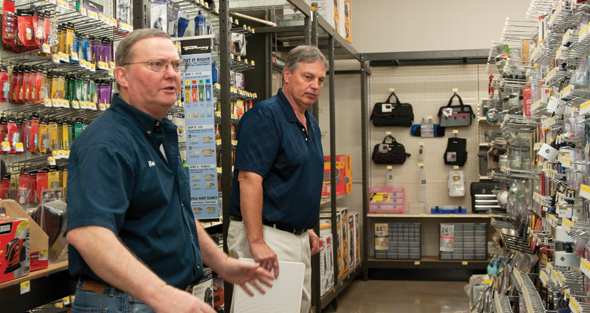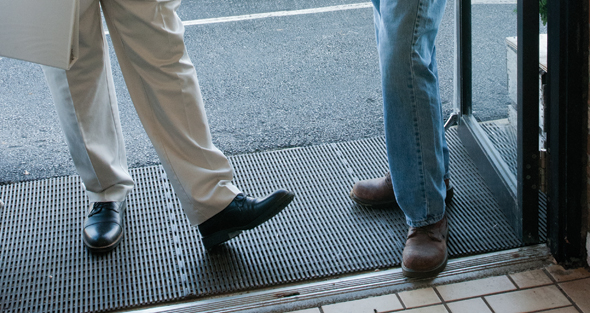The sharp tools, blades, machinery, hazardous chemicals and heavy product stocked high in racking systems are the kinds of images that keep Kelly Brown up at night. They’re also what keep the retail safety expert and expert witness for Robson Forensic, a company that provides testimony and investigation for lawyers and insurance companies, in business. Brown shutters as he walks past bales of straw stacked against the side of Loganville True Value Plus in Loganville, Pa., as he begins a safety audit of the store. Since flammable gas cans are stored on the other side of the wall in the store’s back room, one spark and the straw could ignite, offering the perfect fuel for a devastating fire, he says. “That kind of claim could result in a total loss for a business,” Brown says.
Pitting the store against that kind of risk was certainly not what owner Scott Hittie and store manager Ron Werner intended—storing the straw outside the store’s back room was convenient for employees loading it with the forklift stored there—but now they realize the safety implication and are taking proper action to correct it.
There are many other areas around your own store that could be putting your customers and employees at risk—and could potentially cost you expensive litigation or insurance claims. Use True Value Plus’s Loganville branch safety audit as a guide for an unbiased examination of your own store. While this article should serve as a helpful starting point, always consult with a professional safety expert when it comes to safeguarding your operation.
Safety Training
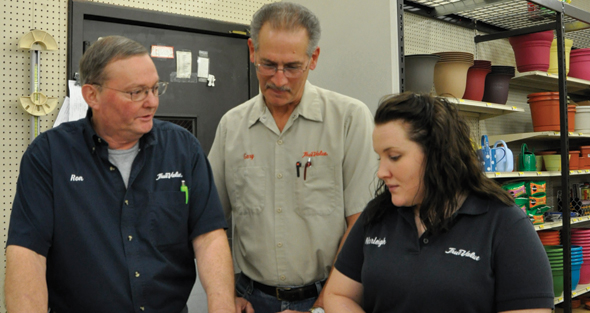 Brown says it’s imperative to dedicate the resources and time to properly train employees on safety. This starts with stressing a culture of safety from the top. Employees will look to upper management to set the bar, so managers should make a daily visible commitment to workplace safety and not just correct employees who don’t follow the policies. Werner and Hittie passed this portion of the audit with flying colors—they conduct one-on-one training for special equipment and propane tank handling and discuss safety topics at the company’s quarterly staff meetings. Werner is also American Red Cross certified, while other employees have received CPR training—one even has certification in forklift operation.
Brown says it’s imperative to dedicate the resources and time to properly train employees on safety. This starts with stressing a culture of safety from the top. Employees will look to upper management to set the bar, so managers should make a daily visible commitment to workplace safety and not just correct employees who don’t follow the policies. Werner and Hittie passed this portion of the audit with flying colors—they conduct one-on-one training for special equipment and propane tank handling and discuss safety topics at the company’s quarterly staff meetings. Werner is also American Red Cross certified, while other employees have received CPR training—one even has certification in forklift operation.
Best practices:
- Ensure there is a sound safety orientation program that is supplemented with daily, weekly or monthly safety topics and inspections that include interactive safety awareness questions.
- Safety committee meetings should be held at least quarterly. The committee should review store inspections, identify accident-prone areas in the store, adopt preventative actions and communicate their findings to all employees. Check with your state’s safety laws—you may be eligible to take 5 percent off your workers’ compensation premiums for having a state-certified safety committee.
- NRHA also has a program available to help your business stay safe and compliant. For more information on these training tools, visit www.nrha.org/v2/Training/Loss_Prevention.aspx.
Expert Inspections
 The Occupational Safety and Health Administration (OSHA) is working to ensure all states require a safety program for businesses in the next decade, so retailers should start developing their OSHA-compliant program now by enlisting the services of their insurance companies. Brown says a Certified Safety Professional would be a good person to utilize to conduct the assessment and determine what OSHA programs should be in place. A certified retail safety expert or your insurance broker can also advise on how to develop a written OSHA-compliant program, a self-inspection program, safety training programs, safety awareness programs and more in a cost-effective manner.
The Occupational Safety and Health Administration (OSHA) is working to ensure all states require a safety program for businesses in the next decade, so retailers should start developing their OSHA-compliant program now by enlisting the services of their insurance companies. Brown says a Certified Safety Professional would be a good person to utilize to conduct the assessment and determine what OSHA programs should be in place. A certified retail safety expert or your insurance broker can also advise on how to develop a written OSHA-compliant program, a self-inspection program, safety training programs, safety awareness programs and more in a cost-effective manner.
Best practices:
- Retailers should also check at the state level to ensure they are compliant with their state’s specific program; several states have annual safety requirements and safety committee and/or safety inspection requirements for businesses.
- Conduct “safety sweeps” in all departments through the store. Items that require repair or replacement should be noted on a safety checklist. For more information on developing an OSHA-compliant safety program and conducting self-inspections, visit https://www.osha.gov/Publications/smallbusiness/small-business.html. (Note: These checklists are not all-inclusive. Refer to OSHA standards for specific guidance that may apply to your work situation.)
Parking Lot/Exterior
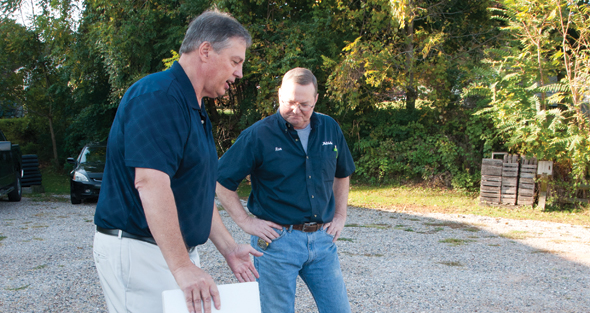 There are several potential risks in this area, whether it be tripping hazards from cracks in pavement or pavement depressions that will collect water and cause slick ice, the potential for break-ins due to improper lighting or the potential for flammable materials stored outdoors to catch fire. In addition to the bales of straw stored just outside the store’s back room, Brown found flattened cardboard boxes—a potential fire hazard. He recommended Werner clear all debris and fall hazards from the parking lot daily and have all cracks in pavement filled to prevent any slips and trips. Brown also found the store’s propane tank filling station was located more than 50 feet away from the main structure, mitigating explosion or fire risk.
There are several potential risks in this area, whether it be tripping hazards from cracks in pavement or pavement depressions that will collect water and cause slick ice, the potential for break-ins due to improper lighting or the potential for flammable materials stored outdoors to catch fire. In addition to the bales of straw stored just outside the store’s back room, Brown found flattened cardboard boxes—a potential fire hazard. He recommended Werner clear all debris and fall hazards from the parking lot daily and have all cracks in pavement filled to prevent any slips and trips. Brown also found the store’s propane tank filling station was located more than 50 feet away from the main structure, mitigating explosion or fire risk.
Best practices:
- Keeping open lines of sight is important for security reasons, so avoid placing large signs on windows or planting large shrubbery that might obstruct the view into or out of the building and ensure there is adequate lighting inside and outside of the building.
- Make sure winter weather programs, snow removal equipment and contracts, as appropriate, are in place in snow- and ice-prone regions.
- If handled locally, ensure shovels, snow blowers, ice melting products and warning signs are available and ready for the first snow.
- Be aware of and report anything that could cause a fire and clear any cardboard or paper products away from hot surfaces or heating equipment.
Entrance
While it’s not likely you can change out the flooring throughout your store to make all the walking surfaces slip resistant—slips, trips and falls are common causes for retail litigation (Brown says the average cost for this type of litigation is around $30,000)—it may be possible to modify a key area where many incidents occur: the entrance. At Werner’s store, rubber mats are placed just outside the entrance to help eliminate guests from tracking outside elements such as snow or ice through the doors. Inside the entrance, the floor is covered with a carpet mat to help prevent slips. While this mat helps keep the surface dry, it could also present a tripping hazard, Brown says. Ideally, Brown recommended replacing the ceramic tile at the main entrance with a floor covering that is more slip resistant with or without a carpeted mat.
Best practices:
- Brown says the best permanent safety solution is adding matting or gridded systems at the entrance, both of which do a better job of removing water and slush from the bottom of footwear than standard carpet mats. “The return on investment could be realized within the first year as a result of not having incidents in those areas,” he says.
- Brown suggests high-quality entrance matting that reaches at least 15 feet into the store beyond the interior door threshold. Quality mats should lay flat, be free of warped or curled edges, have a slip-resistant backing, be beveled to prevent trips and be durable and easy to clean.
Merchandising and Displays
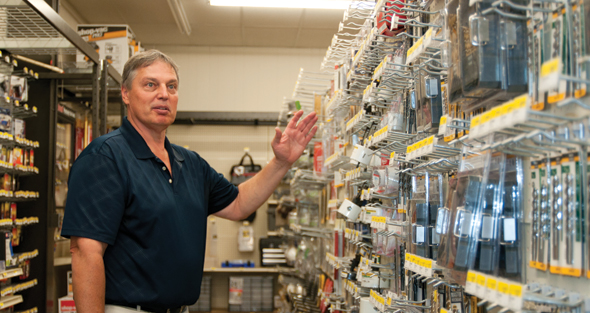 Common causes for injury in this area include empty endcaps, poor or no visibility of the base of a fixture, sharp-ended display hooks and damaged fixtures. All are examples of tripping hazards, Brown says; customers could also easily injure themselves on a low-hanging empty hook when reaching for another product on a higher shelf. Werner makes safety adjustments on displays almost daily—and it shows. Brown found clear, wide aisles with displays featuring short, labeled peg hooks and distinguishable deck bases. Brown did point out one protruding endcap slightly obstructing movement with a few stray empty, non-labeled peg hooks.
Common causes for injury in this area include empty endcaps, poor or no visibility of the base of a fixture, sharp-ended display hooks and damaged fixtures. All are examples of tripping hazards, Brown says; customers could also easily injure themselves on a low-hanging empty hook when reaching for another product on a higher shelf. Werner makes safety adjustments on displays almost daily—and it shows. Brown found clear, wide aisles with displays featuring short, labeled peg hooks and distinguishable deck bases. Brown did point out one protruding endcap slightly obstructing movement with a few stray empty, non-labeled peg hooks.
Best practices:
- Properly assemble, critique and store merchandise on displays, placing heavier merchandise on lower levels and avoiding overcrowding product on a shelf or display base. Broken or damaged merchandise should be removed immediately, marked out of stock and disposed of properly.
- Put controls on heavier or awkward merchandise to keep it secure. Keep the product off the floor and have an employee retrieve it from the back for customers or place signage directing customers to ask for assistance with retrieving these items.
- Endcap shelves should be maintained full or the empty shelves removed.
- Floor displays should be at least 3 feet tall to reduce tripping hazards.
- Displays with blades should be covered with protective guards, while cutters should be cabled.
Ladders and Stepladders
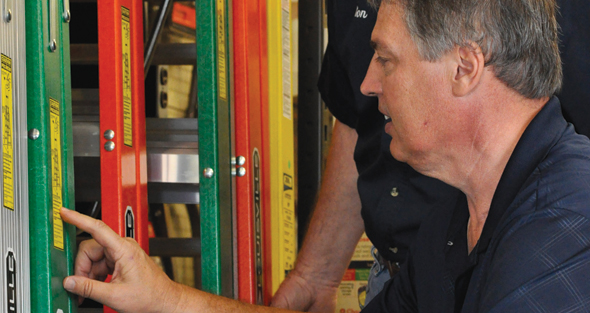 Brown, who also works with Zurich Insurance as a retail industry consultant, says the largest workers’ compensation loss his agency has seen was the result of a customer falling from a stepladder. At True Value Plus’s Loganville branch, Brown found some unsecured ladders in the store’s back room and a stray, unmarked stepladder stored on the salesfloor, which Brown says could pose a serious safety hazard if a customer were to use it to grab something from a high shelf and fall without asking for employee assistance.
Brown, who also works with Zurich Insurance as a retail industry consultant, says the largest workers’ compensation loss his agency has seen was the result of a customer falling from a stepladder. At True Value Plus’s Loganville branch, Brown found some unsecured ladders in the store’s back room and a stray, unmarked stepladder stored on the salesfloor, which Brown says could pose a serious safety hazard if a customer were to use it to grab something from a high shelf and fall without asking for employee assistance.
Best practices:
- Using an extension ladder to retrieve stock can create an unsafe condition because the design is not stable enough to permit the employee to hold the article and climb safely. Instead, it is best to use a stock ladder that has a stable
- base platform.
- Metal ladders should not be used to change light bulbs because the ladder material is electrically conductive.
- Stepladders should be in good condition and not missing any parts. Rubber feet should be intact and in good condition.
- Always keep areas clear around the top and bottom of ladders to avoid creating a trip hazard.
- Keep ladders off the salesfloor unless an employee directly attends them. Ladders for sale should be chained and clearly labeled to prompt customers to ask for assistance.
Special Equipment/Saws
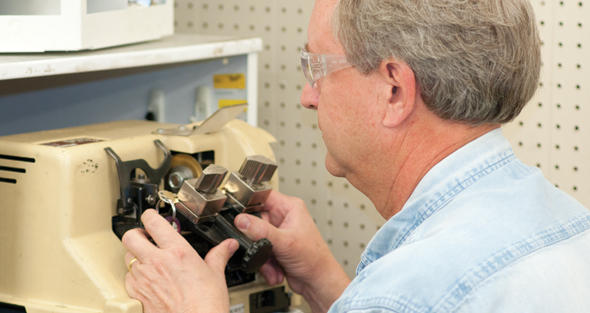 True Value Plus’s Loganville branch offers several in-store services that pose potential safety hazards, including blade, knife, scissor and chainsaw sharpening and screen, glass and key cutting. Employees also use a forklift to lift lumber and heavy loads for customers. Out of all these pieces of service equipment at the store, Brown found only an out-of-date sharpener that he recommended be replaced.
True Value Plus’s Loganville branch offers several in-store services that pose potential safety hazards, including blade, knife, scissor and chainsaw sharpening and screen, glass and key cutting. Employees also use a forklift to lift lumber and heavy loads for customers. Out of all these pieces of service equipment at the store, Brown found only an out-of-date sharpener that he recommended be replaced.
Best practices:
- The best way to prevent loss in this area is to make sure employees receive the proper training and/or certification before attempting to operate equipment themselves. This equipment includes saws, cutters, sharpeners, pallet jacks, forklifts, propane tanks and lift platforms.
- Make sure all equipment is in good working order and know how to identify licensed operators and servicers of this equipment. For example, forklift operators must be certified by OSHA; training can be completed on the job, or employees can attend a trade school. If an employee opts to take an individual online certification course, he’ll still need to be evaluated by a qualified trainer for the hands-on part of the certification process. An alternative is to consider taking an OSHA Outreach Training Program Course, which will teach you how to certify forklift operators yourself.
- Personal protective equipment (safety glasses, gloves, knee pads, shoe wear, respirators or dust masks) should be worn for all specific tasks or jobs in the store that require such equipment.
Hazardous Chemicals/Products
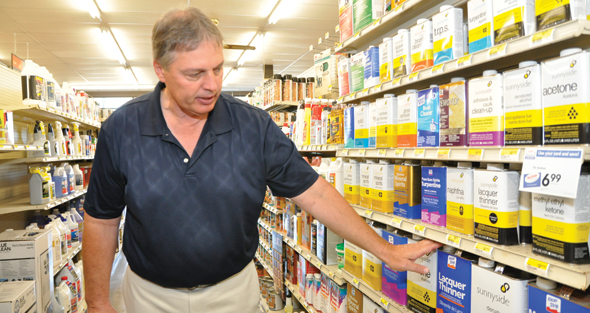 In this safety area, Brown found True Value Plus’s Loganville branch to be mostly safety compliant. All poisonous chemicals, solvents and fertilizers are clearly labeled, and labels pointing out safety warnings on hazardous chemicals are facing out on shelves. Werner also makes sure to store liquid chemical products below solid items on shelving so liquids don’t spill down onto the items below, thus preventing the possibility of any hazardous fumes or spills. He cleans up spills on the salesfloor immediately and uses warning signage to caution customers that area may be slick. Additionally, Brown found tools powered by gasoline were displayed on the salesfloor with empty tanks to prevent any accidental starts.
In this safety area, Brown found True Value Plus’s Loganville branch to be mostly safety compliant. All poisonous chemicals, solvents and fertilizers are clearly labeled, and labels pointing out safety warnings on hazardous chemicals are facing out on shelves. Werner also makes sure to store liquid chemical products below solid items on shelving so liquids don’t spill down onto the items below, thus preventing the possibility of any hazardous fumes or spills. He cleans up spills on the salesfloor immediately and uses warning signage to caution customers that area may be slick. Additionally, Brown found tools powered by gasoline were displayed on the salesfloor with empty tanks to prevent any accidental starts.
Best practices:
- Make sure vendors provide “hold harmless” agreements and indemnify you for any and all losses associated with their products and that they properly train management and employees on the hazards associated with their products.
- Also ensure installers and vendors are properly insured in the event of a catastrophic loss. Make sure product recall notices are monitored and hazardous products are removed from displays and discarded as directed by the Consumer Product Safety Commission and the manufacturer.
- Know the location of Material Safety Data Sheets (MSDS) and familiarize yourself with the location of the “cleanup” closet and associated tools.
What if there’s an accident?
Even with the proper safety precautions, accidents do happen. Safety expert Kelly Brown shares best practices for what to do if someone is injured in your store:
- Employees should be trained to notify management immediately and stay with the accident victim until help arrives and do no further harm.
- If there is an exception for management and employees to provide first-aid to customers and employees, they should be trained on first-aid, CPR and/or automated external defibrillator (AED) use as appropriate and recertified as required (Corporate legal documents should sign off on first-aid protocols established in the field).
 Hardware Retailing The Industry's Source for Insights and Information
Hardware Retailing The Industry's Source for Insights and Information


